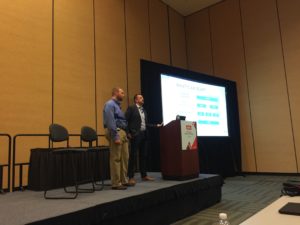OpenSCAP is a security framework for determining the compliance of a system to some defined set of standards. Jeffrey Blank of the National Security Agency and Shawn Wells of Red Hat gave their talk on automated compliance.
We, as an industry, needed standardized formats for automated checklists. Specifically, we needed:
- Standardized inputs
- Standardized outputs
- Provide product independence
SCAP is the standard and its checklist language is called XCCDF. Check instructions are detailed in OVAL or OCIL languages, which are open standards. Enumerations are defined in CCE, CPE and CVE, basically providing a way of providing identifiers for particular things (vulnerabilities, etc). Risk is detailed in the CVSS framework. You can read more about these on the SCAP website.
The US Government provides NIST FIPS 140 and NIAP Common Criteria evaluation programs. Common Criteria looks at source code and performing testing to verify that a vendor's claim actually matches implementation. FIPS is validation of security modules. The protection profiles are developed and kept on GitHub. SCAP is the US Federal standard to perform security automation to ensure compliance with these profiles and programs. Basically, SCAP provides a mechanism to query a system to make sure it is compliant with everything which applies to that system.
Red Hat has open sourced and released the SCAP Security Guide, which provides baseline standards for compliance. Shawn calls them "nerd nobs", which is just awesome. Security baseline updates are included as part of RHEL minor releases (7.2, 7.3, etc). Red Hat is shipping the following SCAP profiles:
- RHEL 7.2
- PCI-DSS
- RHEL7 Vendor STIG
- RHEL 7.3
- FBI CJIS
- CIA's C2S
- Certified Cloud Provider
- FISMA Moderate
Shawn then went on show a live demo, which can be viewed as part of the course content. OpenSCAP is something that sounds extremely dry, but can be very valuable for your organization. If you have ever had the pleasure of sitting through security, PCI and/or SOX audits, you'll understand how having OpenSCAP enabled in your organization can save you from a lot of pain. If you have not experienced this joy, just do it for your InfoSec team, they will love you.
About the Author
Brian J. Atkisson is a Senior Principal Systems Engineer and the technical lead on the Red Hat IT Identity and Access Management team. He has 18 years of experience as a Systems Administrator and Systems Engineer, focusing on identity management, virtualization, systems integration, and automation solutions. He is a Red Hat Certified Architect and Engineer, in addition to his academic background in Biochemistry, Microbiology and Philosophy.
Last updated: March 16, 2018

